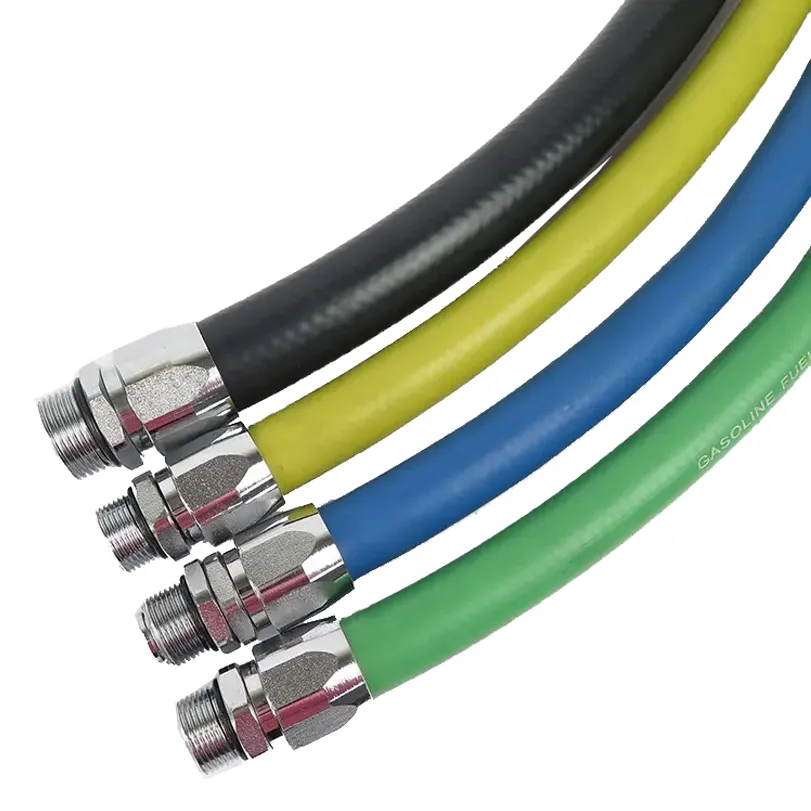335345435
Dec . 02, 2024 07:01 Back to list
thermoplastic hydraulic hose
Understanding Thermoplastic Hydraulic Hoses
Hydraulic hoses are essential components in various industrial applications, serving as conduits for transferring fluids under pressure. Among the different types of hydraulic hoses, thermoplastic hydraulic hoses have gained significant popularity due to their unique properties and advantages. This article will delve into the characteristics, benefits, applications, and maintenance of thermoplastic hydraulic hoses.
What are Thermoplastic Hydraulic Hoses?
Thermoplastic hydraulic hoses are made from synthetic materials that can be molded and reshaped when heated. Unlike rubber hoses, thermoplastic hoses are crafted from thermoplastic elastomers (TPE), polyamide (nylon), or other thermoplastic materials. This composition gives them a distinctive set of properties that differentiate them from traditional rubber hoses, particularly regarding durability, weight, and flexibility.
Key Characteristics
One of the standout features of thermoplastic hydraulic hoses is their excellent resistance to abrasion, making them suitable for environments where hoses are subjected to wear and tear. They also exhibit superior chemical resistance, allowing them to handle a wide range of hydraulic fluids, including oils, fuels, and other chemical compounds.
In terms of weight, thermoplastic hoses are generally lighter than their rubber counterparts, which can be a critical advantage in applications where reducing weight can enhance overall efficiency. Additionally, the flexibility of thermoplastic hoses enables easier installation and routing in complex machinery or tight spaces without compromising performance.
Benefits of Thermoplastic Hydraulic Hoses
1. Lightweight and Compact The reduced weight of thermoplastic hoses makes them easier to handle and install, which can result in lower labor costs and increased efficiency during usage.
2. Enhanced Durability Their resistance to abrasion and potential damage from chemicals makes thermoplastic hoses a reliable choice for demanding environments, ensuring longer service life and reducing the need for frequent replacements.
4. Lower Pressure Drop The smooth inner surface of thermoplastic hoses leads to reduced friction and lower pressure drops in hydraulic systems, enhancing overall efficiency.
5. Less Maintenance Thermoplastic hoses are less susceptible to the effects of aging and weathering compared to rubber hoses, leading to reduced maintenance requirements.
thermoplastic hydraulic hose

Applications
Thermoplastic hydraulic hoses are employed across various industries, including
- Construction They are used in hydraulic machinery such as excavators, loaders, and cranes, where durability and flexibility are essential. - Agriculture In farming equipment, these hoses facilitate the transfer of hydraulic fluids for operational efficiency.
- Manufacturing Assembly lines often utilize thermoplastic hoses for hydraulic systems, ensuring unobstructed movement and reliable performance.
- Automotive They can be found in hydraulic systems of vehicles, particularly in high-performance applications where reduced weight is crucial.
Maintenance Tips
To ensure the longevity of thermoplastic hydraulic hoses, consider the following maintenance tips
1. Regular Inspections Frequently check hoses for signs of wear, kinks, or abrasions. 2. Proper Storage Store hoses in a cool, dry place to prevent exposure to extreme temperatures and direct sunlight.
3. Correct Installation Avoid sharp bends during installation to ensure fluid can flow freely and reduce stress on the hose.
4. Flush the System Regularly flush hydraulic systems to remove contaminated fluids that can affect hose integrity.
Conclusion
Thermoplastic hydraulic hoses represent a versatile and high-performance solution for various hydraulic applications. Their unique properties, such as lightweight design, durability, and chemical resistance, make them a preferred choice in many industries. Understanding their benefits and adhering to proper maintenance practices can maximize their performance and lifespan, making them an invaluable asset in hydraulic systems.
-
High-Quality Distribution PTFE Hose for Industrial Flexibility
NewsJul.23,2025
-
Durable Pressure Washer Rubber Hose for Hot Water & High Flexibility
NewsJul.22,2025
-
Twin Hydraulic Hose for Efficient Fluid Transfer | Durable & Flexible
NewsJul.22,2025
-
Twin Hydraulic Hose | High Pressure & Durable
NewsJul.21,2025
-
Discount Hydraulic Hose Factories | Top Quality & Discounts
NewsJul.20,2025
-
EN856 4SP Hydraulic Hose - High Pressure & Durable
NewsJul.20,2025



